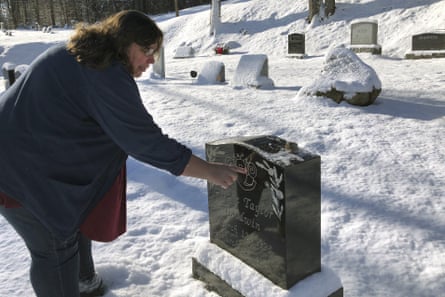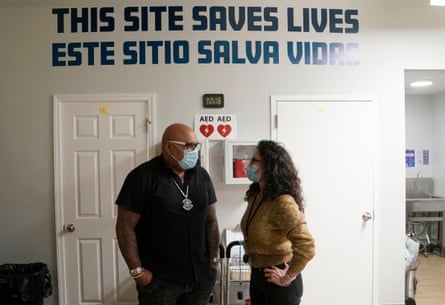Fentanyl – the deadliest drug in the country – is getting even more dangerous. Across the United States, the opioid is increasingly being mixed with xylazine, a powerful tranquilizer that’s approved by the Food and Drug Administration for use in animals such as horses. But on the streets it’s known as “tranq” or “tranq dope”, and it’s been linked to horrific side effects and a growing number of deadly overdoses across the country.
The substance was first found mixed with heroin in Puerto Rico as early as two decades ago. Today the national center of the crisis is Philadelphia, where xylazine appeared in the drug supply as early as 2006, and was found in over 90% of the city’s lab-tested dope samples in 2021.
Last week, the US Drug Enforcement Administration issued an alert about a “sharp increase in the trafficking of fentanyl mixed with xylazine”, saying it had seized xylazine and fentanyl mixtures in 48 out of 50 states. The FDA has vowed to crack down on imports of the drug, and a new bill in Congress would add xylazine to the DEA’s list of controlled substances.
But doctors and advocates say that there’s still a glaring lack of understanding about the problem and how to fight it.
James Latronica, an addiction medicine doctor and the public policy chair of the Pennsylvania Society of Addiction Medicine, has been treating patients who have taken xylazine for years now. Xylazine isn’t something people are seeking out purposefully, he says. “You have an unregulated, unknowable supply that can be cut with whatever is at hand,” and from a supplier’s perspective, “it’s likely that it’s simply cheaper than fentanyl”.
Xylazine adds multiple layers of complexity to an already treacherous drug crisis. Xylazine is a depressant. It slows a person’s breathing and heart rate, and lowers their blood pressure. An overdose can put them into a coma-like state, leaving them frozen and vulnerable for hours on the street.

Typically, rescuers use a medication called naloxone (often sold as Narcan) to reverse fentanyl overdoses, but if someone takes too much fentanyl mixed with xylazine, even Narcan might not wake them. Rescuers might end up using too much of the medication, which could make the person vomit and possibly choke.
Xylazine has an especially devastating side effect: gruesome wounds that don’t heal. The exact reason for this still isn’t understood, but scientists suspect xylazine could be affecting blood circulation in a way that affects skin repair. That means that for someone using xylazine, something as small as a pimple or a needle puncture could turn into large sores of dying flesh, in some cases eating through to the bone.
The shame of the wounds dissuades some patients from seeking help, “and then those ones get worse”, says Latronica. Around two years ago, he encountered an addiction patient who had repeated infections on his arms, but had no health insurance and struggled to get assistance. “Eventually, he just stopped going until his arm was so bad that it was gangrenous. And there was nothing to do except to amputate it.”
Despite the hallmark symptoms, Latronica didn’t have a way of confirming if the patient was using xylazine, because there weren’t readily available tests. “Unfortunately, doctors and public health are always behind. We’re having conferences and learning about xylazine, but it’s been around for several years already – and that’s probably the single most frustrating part of this field.”
Local non-profits are desperately trying to help. In 2021, Shannon Ashe, a Philadelphia social worker, co-founded The Everywhere Project, a group of volunteers that provide food, clothing, wound care, and clean supplies to people using substances like xylazine. What she witnesses is undeniably grim: “the wounds look as if people have been through some sort of horrendous chemical warfare,” she says. But they’re not chemical burns – “they’re coming from the inside.”
To reduce stigma, Ashe says, tackling xylazine requires an approach called harm reduction: “meeting people where they are, without judgment, in a way that respects their goals for themselves.” Her group doesn’t require abstinence: “If people want to do that, that’s great. If you want to go to treatment, that’s wonderful, we’ll literally get you an Uber. But that’s not our end-all be-all goal.” Requiring that someone stop using xylazine before helping them is just another “unrealistic expectation that leads us to the same spot,” she says, “which is more dead people.”
As a model, Philly advocates point to a New York City non-profit called OnPoint NYC, which recently opened the country’s first two sanctioned overdose prevention centers – locations approved by authorities where people can use substances in a clean, supervised setting without fear of getting arrested. Since opening in 2021, OnPoint’s sites have been used almost 70,000 times, during which staff intervened in just under 850 overdoses, 65% of those “heavily adulterated with fentanyl,” says Kailin See, the non-profit’s director of programming. Because of how closely they supervise people, OnPoint has only had to call an ambulance 14 times, and nobody who has overdosed there has died.
Because it’s publicly approved, OnPoint is able to work with the city’s health department to track xylazine rates in the city. “Four or five months ago, we were seeing just trace amounts,” says See. But now, “we’re starting to see batches that are considerably higher – upward of 25% concentration xylazine in the bags.”

The monitoring has won the non-profit extra time to learn how to treat xylazine’s symptoms, from its coma-like overdoses to its signature wounds. “We are at a huge advantage in terms of preparing for its arrival,” says See. “We are not going to embark on a fear-based approach.”
That’s in contrast to “war on drugs”-style policies that criminalize and punish people using substances. Tools as simple as fentanyl test strips are still banned in states like Florida and Texas over fears that they could encourage drug use. And overdose prevention centers remain deeply unpopular ideas in much of the country, where residents and politicians say they’ll enable addictions and increase crime.
But “I can’t treat someone’s addiction if they’re already dead,” says Latronica. He praises a recent bill passed in Pennsylvania that legalized the strips – something he hopes will clear the way for xylazine tests to become more widely available as well. An effort to open an overdose prevention center in Philadelphia has the support of city officials, but remains stuck in a legal battle and faces opposition from neighbors.
Just having tests won’t solve the crisis, advocates say. “When you test your drugs, it’s not going to deter people from using those substances, because that’s just not how addiction works, and that’s not how poverty works,” says See. “People are not going to have the choice to say, ‘Oh, there’s a dangerous adulterant in my dose, I’m going to go buy a ‘cleaner’ dose.’ What ultimately is important is safe spaces for people to use.”
And to go a step further: a safer supply. Some countries, including Canada, allow doctors to prescribe pharmaceutical-grade versions of street drugs in the case of severe addictions – which gives people a way to avoid fentanyl cut with xylazine, or hepatitis C from a tainted needle. In cases like these, harm reduction approaches might be thought of as a kind of preventive medicine, says Latronica.
Despite xylazine’s horrors, advocates hope it could serve as another wakeup call for a national breakthrough in drug policy. See says there’s “a mountain of peer-reviewed evidence” to suggest that overdose prevention centers would make a difference in the opioid crisis, “but what’s important for Americans is American examples and American evidence”.
In the last two years, OnPoint has held tours for hundreds of curious officials from other US cities. “Nobody wanted to be the first to do it,” says See. “And we’re just hoping that everybody wants to be second.”
